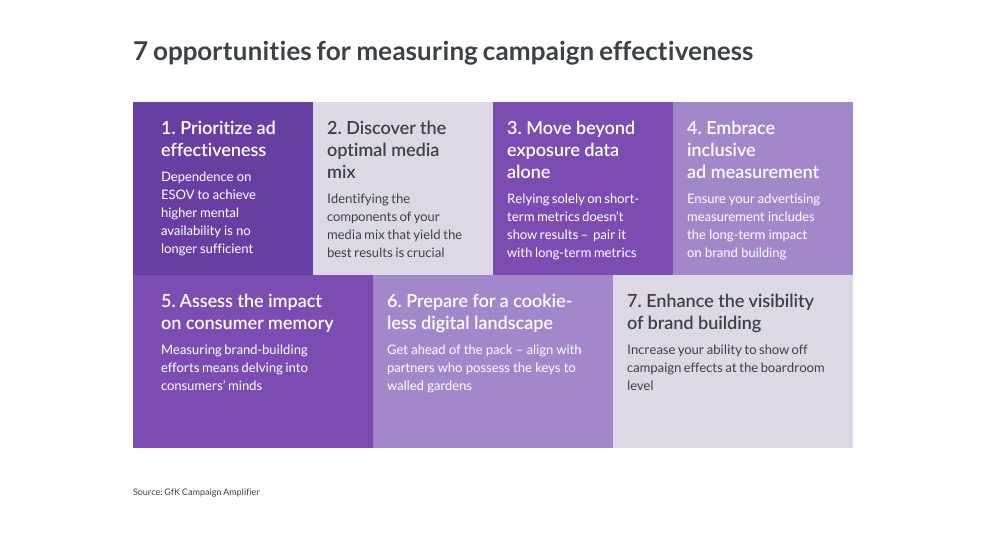In the evolving online landscape, gauging ad effectiveness and justifying marketing spend is increasingly important – and challenging. Marketers must transcend multiple obstacles, the attention issue in particular, to achieve optimal exposure with their valuable long-term brand-building campaigns.
“How do you really know if your brand-building efforts are paying off? Advertising is not as effective as it was in the past. Capturing human attention is an uphill battle. The direct link between attention and mental availability means memories can only be etched in the minds of consumers who have truly seen and engaged with your ad. This issue is made more intricate by the complex media landscape, with attention levels varying across different platforms. It’s crucial to access insights that highlight where investments are paying off and where they can be optimized to cut through the attention barrier and build strong brand memories.”
Markus Saffer, Head of Brand & Marketing Intelligence, GfK
The cost of investing short
The gradual decay in advertising effectiveness in recent years has exposed the fact that relying on excess share of voice (ESOV) to gain higher mental availability no longer works. Excess investment in short-term sales activation, driven by the pursuit of immediate and easily measurable sales gains, has been exacerbated by the rise of digital channels. The assumption is that relying solely on sales activation ads on these channels has led to a downward spiral in effectiveness.
An industry shift towards refocusing and rebalancing efforts on brand-building campaigns has resulted in a modest recovery in overall effectiveness in 2023. The shift has marked the beginning of a new trajectory towards improved effectiveness.
Two campaign types, working together to achieve exponential reward
There are typically two types of campaigns, each following a distinct trajectory to achieve sales success. When used together and in the right balance, their rewards can be exponential.
Sales activation campaigns are highly focused, targeting individuals likely to make purchases in the very near future. Their goal is to leverage existing brand equity to generate immediate sales. These campaigns employ rational persuasion techniques using information-rich media, designed to facilitate a seamless customer journey. The result of such campaigns is an instant sales uplift in response to the campaign, but they tend to experience rapid decay, with no cumulative sales impact over time.
On the other hand, brand-building campaigns lay the foundation by creating brand equity. These campaigns establish mental structures that predispose potential customers to choose one brand over another, immediately or in the future. They operate by priming consumers long before they enter the buying phase and, since they are not targeted to a specific audience, they require broad-reach media. These emotive and culturally rich campaigns aim to build deep brand associations in consumers’ minds, influencing future purchases.
The importance of the long-term
By allocating a more balanced investment to both brand building and sales activation, marketers can achieve exponential sales growth, with brand building emerging as the most valuable long-term investment. This long-term effect is significant, adding as much as 76% uplift to your sales KPI, provided sufficient time for accumulation.
The cost of measuring short
Conventional campaign measurement methods, which primarily focus on sales activation triggers, are short-term and one-dimensional. A critical shortcoming is the lack of visibility into the impact of long-term brand-building efforts on future sales. Very few marketers can present evidence of their brand-building strategy’s success in the boardroom using short-term sales metrics. Consequently, as little as 24% of campaign effects are visible at the board level when long-term brand insights are unaccounted for.
Building positive mental associations increases the probability of future brand choice. The challenge of measuring the minds of consumers, the portion of advertising that mostly eludes standard measurement methods, further compounds the issue. Successful campaigns must drive exposure and reach, grab and hold attention, and build memories and emotional connections to exert a genuine influence on purchase decisions. Therefore, the approach to measurement needs to be human-centered.

Despite substantial efforts, identifying which parts of your advertising creative are actually working remains a persistent challenge. Relying solely on exposure or attribution data proves insufficient, leaving major gaps in understanding without any visible link to successful outcomes. Moreover, the limitations posed by walled gardens create additional hurdles in accurate exposure measurement. Up to 77% of digital ad spend is now locked behind walled gardens – and is expected to rise to 86% by 2026 (Source: Statistica 2023).
The importance of building brand identity through campaigns as a valuable investment means marketers can’t afford not to know where their efforts are having the most impact. Despite the attention challenges within the realm of paid online media, there has been no reduction in the significance of building brand equity in influencing purchase decisions. The resilience of brands in consumers’ perceptions remains as crucial as ever in shaping the choices they make.
Our Brand Architect foundation research proves that as you build the strength of your brand in consumers’ minds, there is a very high probability of market success. This success is measured through our Brand Strength Index, a combination of both brand choice and brand premium measures, thus defining market success as influencing consumers choices as well as their willingness to pay more for your brand.
The opportunity of attention
The attention problem is complex as brands need to balance consistent long-term messaging without irritating potential customers or being outright ignored thanks to ad skippability and scrollability. Karen Nelson-Field’s research on attention brought to light a startling finding: out of the 130,000 digital ad views she examined, a whopping 85% failed to attain the required 2.5 seconds or more of active attention needed to influence brand recall and contribute to the establishment of mental availability.
The longer an ad captures active attention, the more enduring its impact on memory, extending its effectiveness. Nelson-Field also emphasizes that different platforms have inherent attention limits, which are primarily determined by the platform and format, not the creative content. Consequently, building a brand strategy with attention at its core is crucial.
In our next article, we explore the intricate interplay between creativity and channel optimization in mastering marketing effectiveness and the attention economy.
Cutting through the attention barrier to build lasting memories
Marketers need to be enabled to measure the cross-media impact of their ad campaigns and optimize the factors that drive success. Brand-building strategies need to hone in on two key areas:
- Drive exposure and grab attention
- Build positive brand memories that persuade purchase now and in the future
Understanding how to reach your target audience, optimal frequency, and cross-channel exposure is crucial for driving success and maximizing mental availability. However, you can only change what you can measure. To enhance performance in these two areas, marketers need measurable insights that gauge campaign impact and allow them to deconstruct the elements that contribute to effective reach, frequency, and channel exposure. By optimizing these foundational drivers of success, marketers can magnify the potency of their campaigns and achieve amplified results.
GfK Campaign Amplifier empowers you to measure marketing campaign effectiveness and the true influence of your brand campaigns, safeguard your budget, amplify reach and frequency to outshine competitors, and multiply value through attention-grabbing creative that fosters positive brand connections.
Watch our Masterclass “Cross Media: Measure, Understand, Grow” on demand to learn how to measure the full effect of your brand-building campaign and its cross-media spend. With experts from Meta and GfK. (Available in English and German)





